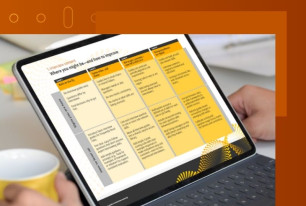On the Sofa with Anna Sommer: How the Change in Candidate Behavior Has Impacted Hiring Processes
In this edition of On the Sofa blog series, Anna Sommer talks about virtual hiring and the impact of candidate behavior change on the hiring processes.
Share
In this edition of On the Sofa blog series, Anna Sommer talks about virtual hiring and the impact of candidate behavior change on the hiring processes. In a candidate-driven market, one misstep can lead to missing out on the best talent. We talked to Anna Sommer, SHL’s Senior Consultant, about why measuring each step of your hiring process, promoting organizational culture upfront, and having a structured development are key.
Can you tell us a bit about your role at SHL and what you enjoy most?
I am a senior consultant at SHL, based in Cologne, Germany working as part of the European team with clients globally. At SHL, I support customers in many ways, from analyzing their people data to providing insights into their candidates or employees to help them understand their roles and how best to hire, assess, and develop for them. This could be the whole end-end process from the very first screening through to selection or just some elements, for example designing development or assessment centers for that organization.
I am lucky to be able to work with different types of people all over the world almost every day so getting to hear different stories and experiences across a range of backgrounds, roles, and industries is always interesting.
I love that no day is the same and helping organizations identify strengths and how they can leverage them and become better at what they do by stimulating the development of skills is always rewarding as well.
Are virtual hiring processes here to stay?
We know there has been an acceleration in the virtual delivery of assessments and it is great that SHL has led the way in delivering virtual assessments and the majority of our clients are following suit.
Hiring managers, consultants, and candidates can be geographically dispersed, which can create huge cost savings for everyone involved. With online assessments, there is no longer a need for the hiring manager to be present, as the candidates can complete the online questionnaires, and the hiring managers can evaluate their performance at the time that suits them.
The vast majority of customers I speak with still want to see a candidate face to face at some stage, particularly for more senior roles and if that role is office-based. Sometimes, this is at the last stage of the process after they have benefitted from the pre-selection and filtering of candidates being done virtually, or it could be in an assessment center for example, where we can provide both in-person or virtual options depending on the client’s preference.
For talent management initiatives such as development centers, organizations have also moved a lot of these virtually, due to the geographical spread of where their employees may be located but again, many see this more structured development session as a good opportunity to bring people together face-to-face and enhance their learning experience.
Could you tell us a bit about how development centers work?
Development centers are run in a similar way to assessment centers but with existing employees. Instead of the end goal being a decision on whether to hire a candidate, development centers are more focused on investing in participants, providing them with a thorough understanding of their strengths and areas of development that they can continue working on within their role.
From an organizational viewpoint, they learn where they can better utilize and leverage employees’ strengths, identify candidates most suitable for promotion or extra responsibility, and build career and development pathways for the company.
How have you seen candidate behavior change?
Candidates have become much more self-confident, and in times of skills shortages, know their value to an organization. They are aware that companies are willing to go to greater lengths to attract the best talent and so scrutinize potential future employers very closely and it is not unusual for them to have several offers to select from.
This shift from an employer to an employee market also creates more emphasis on hiring efficiently and effectively while not discouraging candidates and still providing them with a good experience. As consultants, we can advise on how to get this balance right.
An unpleasant experience at any point in the hiring process can cause candidates to drop out, whether that is during assessments, interviews, or meeting someone face-to-face for the first time. I have seen examples of candidates not taking up a role as they did not like the office environment when they went visited for an interview, and even dropping out in the middle of virtual assessment centers as they did not enjoy the experience, so all elements of the process need due consideration.
Candidates have become much more self-confident, and in times of skills shortages, know their value to an organization.
How has this behavior shift impacted talent processes at organizations?
The changes in behavior have led to an increased focus on the candidate experience, so that throughout the process there is a focus on what value is being provided to the candidate, as well as for the organization.
Part of what I do in my role is measure where people are dropping off in the process so organizations can change something to improve that. For example, I have seen the composition of assessment centers change to make them more fun and engaging, and ensure insightful feedback is provided to everyone taking part, not just for the one or two that are successful. Another common action is to change the cut-off values so more applicants can progress to the assessment centers or the next stage to give an opportunity to see them in a different environment—or simply because they do not find enough candidates otherwise.
Often talent leaders wait until the end of an intervention to measure the impact, but there are many opportunities to measure impact in the short, medium, and longer term. It can be daunting to start, but it is worth understanding what talent data you have and the insights or actions you can gain from this data, as it can be a game-changer for talent processes.
The other shift I have seen is that employers are seeing the value of providing more information about themselves and doing some employer branding. They realize candidates want to know more about who they are going to be working for, their values, and their culture. We help organizations do this through SHL experiences virtually, and in-person, so the experience for a candidate is more than receiving an invite to take part in an assessment and then expecting them to do their own research into what the working environment may be like.
What would you like to see organizations embrace more in the future? I would like to see all companies finally understand the importance of investing in a structured staff selection and development process. Touching on what I mentioned earlier, in these times when there is a shortage of skilled workers, it is essential to not just identify the right talents but to retain them in the company for as long as possible.
Wrong decisions are all the more expensive today because searching for and finding the right candidates is harder than ever and if somebody turns out not to be a good fit, it can be costly. Ability is something that everyone knows about but potential and fit are just as important. Knowing if someone has the potential to grow and develop within the company and knowing if someone will fit with the values that the organization has, is the difference in retaining someone long-term or having a high employee turnover.
There are some roles that would always need some formal qualifications but for the majority, many companies are now hiring for potential and fit, as they know they can train the skills side of the role but it is much harder to try and change a candidate’s preference for remote-work for example, or their motivations if they do not align with what the business provides.
Get in touch with SHL today to see how your organization can accurately measure the impact of your talent processes and create engaging candidate experiences.










